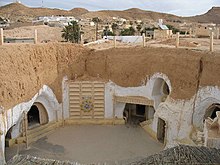<<GotoNote

Tatooine (/ˌtætuˈiːn/) is a fictional desert planet that appears in the Star Wars space-opera franchise. It is a beige-colored, desolate world orbiting a pair of binary stars, and inhabited by human settlers and a variety of other life forms. The planet was first seen in the original 1977 film Star Wars, and has to date featured in a total of six Star Wars theatrical films.
It is the home planet of the protagonist of the Star Wars Trilogy, Luke Skywalker, and also of his father, Anakin Skywalker. Shots of the binary sunset over the Tatooine desert are considered to be an iconic image of the film series.[1][2]
In his early drafts of the Star Wars story, author George Lucas changed the names of planets and characters several times. In his early treatment, Lucas opened the story on the fourth moon of the planet Utapau, the home of a young warrior called Annikin Starkiller.[3] In Lucas's rough draft, The Star Wars (1974), the escaping droids land in a desert on the planet Aquilae; in later drafts the planet again takes the name of Utapau.[4] Prior to production, early artwork commissioned by Lucas from conceptual illustrator Ralph McQuarrie show robots lost on a desert world, scorched by twin suns and mysterious, masked Tusken Raiders riding large horned Banthas.[5][6][7]
George Lucas originally envisaged filming the Utapau/Tatooine scenes in Algeria (inspired by Michelangelo Antonioni's 1975 film The Passenger), Libya or Iran, but these locations were rejected by 20th Century Fox. When production began on Star Wars, production designers John Barry and Robert Watts scouted for filming locations in Morocco and Tunisia. Lucas, accompanied by producer Gary Kurtz visited the Tunisian island of Djerba with them and were impressed by the desert landscape and the unusual architecture, and selected Tunisia to provide the desert planet setting. Lucas was also keen to shoot at the Hotel Sidi Driss in Matmata, a decision which extended the shoot by a day and consequently the budget. Filming in Tunisia began on March 22, 1976, and immediately ran into difficulty: the region was experiencing its first heavy rainfall in seven years, which disrupted the setting of an arid desert planet.[8] The Matmata hotel consisted of a troglodyte dwelling in a large hole in the ground. Combined with shots at Chott el Djerid, near Nefta, this formed the setting for the Lars homestead and moisture farm. The landing site for C-3PO and R2-D2's escape pod was filmed in sand dunes at La Grande Dune, near Nefta, and exterior shots of Mos Eisley spaceport were shot on Djerba.[9][10][11] The name Tatooine is not actually mentioned in the final screenplay of Star Wars—Lucas was still working on his fourth draft while scouting locations, and adapted the name from a town in southern Tunisia called Tataouine (French spelling, or Tatween spelling in Tunisian Arabic).[12]
Certain scenes filmed on Djerba were subsequently deleted from the final cut of the film in order to improve the narrative pace. The most significant material cut was a series of scenes set in the township of Anchorhead which served to introduce the characters of Luke Skywalker and Biggs Darklighter.[13] Lucas asked film editor Richard Chew to cut these scenes as they had been likened to "American Graffiti in outer space" by Fox executives (in reference to Lucas's 1973 film).[14][15]
...https://en.wikipedia.org/wiki/Tatooine